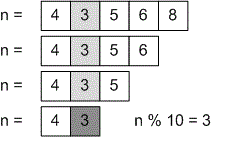Editorial
If the input number is negative, compute its absolute value — this will not change the second digit. Then divide the number by until it is greater than . The last digit of the resulting number will be the second digit of the initial number.

Algorithm implementation
Read the input number . Since it is -bit number, use the long long type. If it is negative, then change its sign to the opposite.
scanf("%lld",&n);
if (n < 0) n = -n;Divide the number by until it is greater than .
while (n > 99) n /= 10;
The last digit of the resulting number will be the second digit of the initial number. Print it.
res = n % 10;
printf("%lld\n",res);Java implementation
import java.util.*;
public class Main
{
public static void main(String []args)
{
Scanner con = new Scanner(System.in);
long n = con.nextLong();
if (n < 0) n = -n;
while (n > 99) n /= 10;
long res = n % 10;
System.out.println(res);
con.close();
}
} Python implementation
Read the input number .
n = int(input())
If the number is negative, then change its sign to the opposite.
if n < 0: n = -n
Divide the number by until it is greater than .
while n > 99: n = n // 10
The last digit of the resulting number will be the second digit of the initial number. Print it.
res = n % 10 print(res)